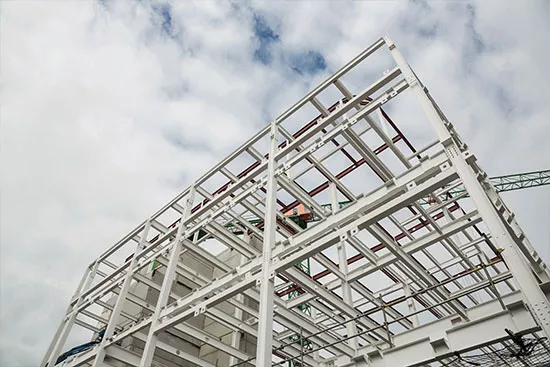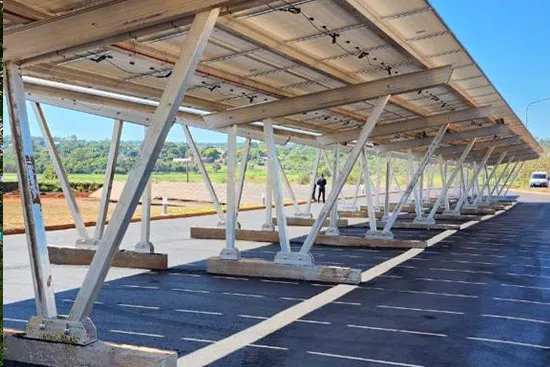Steel structures calculation
Need a steel structure calculation?
The calculation of steel structures is a fundamental process in engineering and architecture that involves the analysis and design of constructions primarily made of steel or other metals. This process focuses on determining how structural components such as beams, columns, and connections interact under different loads and forces to ensure that the structure is safe, stable, and capable of withstanding the demands it will be exposed to throughout its lifespan.Principles of materials mechanics and structural analysis techniques are used to model the behavior of metallic materials and determine the optimal dimensions and proportions of each element. This ensures that the structure is capable of resisting static and dynamic loads, such as gravitational forces, winds, earthquakes, and other possible situations of extreme loading.Steel structures we calculate
Key factors in the calculation of steel structures
Loads and demands
Materials and properties
Elements and connections
Structural analysis
Importance of steel structures calculation
- Safety and Stability: Safety is paramount in any construction project. Proper calculations ensure that the structure is strong enough to prevent collapses and protect people and property from harm.
- Efficiency and Optimization: Precise calculations lead to an appropriate distribution of materials, minimizing waste and reducing construction costs.
- Sustainability: Proper design and calculation can promote sustainability by using efficient materials and reducing environmental impact.
- Regulatory Compliance: Steel structural calculations ensure that projects comply with current regulations and standards, guaranteeing their legal approval.
Contact us
Basic information on data protection
Responsible: Cero Metros Cuadrados, S.L.
Purposes: Manage the sending of information that you request. Sending commercial communications.
Legitimation: Consent. You can withdraw consent at any time.
Recipients: Your data will not be transferred to third parties except in case of legal obligation.
Data subject's rights: To access, oppose, rectify and have their data deleted, as well as other rights as explained in the additional information.
You can access additional and extended information at this link.
FAQ
What are the types of analyses used in steel structures calculation?
In the calculation of steel structures, various types of analyses are employed to assess their behavior and ensure they meet safety and performance requirements. Some of the most common types of analyses include:
- Static Analysis: This analysis examines the behavior of the steel structure under static loads, which are loads that do not change over time. It evaluates internal forces, deformations, and reactions at supports to ensure the structure is stable and does not exceed strength limitations.
- Dynamic Analysis: In this type of analysis, the responses of the steel structure to dynamic loads, such as earthquakes, winds, seismic movements, or moving loads, are studied. It is used to assess the structure’s ability to withstand and absorb vibrations and forces arising from these dynamic loads.
- Stability Analysis: This analysis focuses on evaluating the overall and local stability of the steel structure to ensure it does not exhibit unstable failure modes, such as lateral buckling, torsional buckling, or local instabilities.
- Fatigue Analysis: It is used to estimate the cumulative damage in the structure due to cyclic or fluctuating loads over time. Fatigue analysis is particularly important for structures subjected to variable loads, such as bridges or structures exposed to vehicular traffic.
What are the loads to be considered in the calculation of steel structures?
The primary loads to be considered are dead loads (the weight of the structure itself), live loads (movable loads like people and equipment), wind loads, snow loads (in cold regions), and seismic loads (in earthquake-prone areas).
What is the importance of strength and stiffness in steel structures calculation?
Strength and stiffness are crucial to ensure that the structure can bear the loads and maintain its shape and stability throughout its lifespan. Strength ensures that the structure does not break under the action of the loads, while stiffness ensures that the structure does not deform excessively.
How is the appropriate type of metal section selected for a structure?
The selection of the appropriate type of metal section depends on various factors such as the load it needs to support, the length of the element, environmental conditions, and aesthetic requirements. Catalogs of metal profiles and calculation software are used to determine the optimal section that meets the design criteria.
What considerations are taken into account for the connection of steel elements?
Connections are critical points in a steel structure, and factors such as the load-bearing capacity of the connection, the type of applied load, environmental conditions, and maintenance requirements must be considered. Various types of connections, such as welds, bolts, and joint plates, are used based on the specific needs of the structure.
How is the overall stability of a steel structure evaluated?
The overall stability of a steel structure is assessed through second-order analysis, which takes into account the effects of nonlinear deformations and geometric imperfections. This ensures that the structure does not experience sudden or unexpected collapse under critical loads.
Is it possible to use steel structures in areas with high humidity or corrosion?
Yes, it is possible to use steel structures in areas with high humidity or corrosion, but it is crucial to implement appropriate anti-corrosion protection measures, such as galvanization, special coatings, or the use of stainless steels. The choice of steel type and proper maintenance are essential to ensure the durability and safety of the structure.







